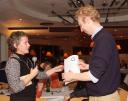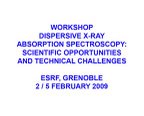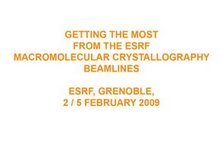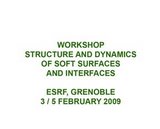- Home
- News
- General News
- Pressure and proteins...
Pressure and proteins feature in the 2009 ESRF Users’ Meeting
09-02-2009
The 2009 ESRF Users' Meeting, which took place from 2 to 5 February and welcomed 300 participants, focused on high pressure studies and on dynamics of proteins during its plenary session. The latter subject was presented by the Young Scientist Award winner, Gergely Katona, an associate professor from Göteborg University. The Users' Meeting also had two well-attended associated workshops and a school.
Share
High pressure has been, and is still, one of the major fields of research being carried out at the ESRF. Over the past 20 years, the use of 3rd generation synchrotron facilities has become essential in the study of materials at very high pressure by using different techniques. Today, there are several beamlines at the ESRF welcoming experiments of this kind, such as ID09, ID27, ID28 or ID24 and it is one of the highlighted areas on which the Upgrade Programme will focus. Paul Loubeyre, keynote speaker of the Users' Meeting plenary session, portrayed in his talk the different possibilities that the ESRF offers, and gave his ideas on future challenges which could be tackled as a result of the upgrade of the facility. Loubeyre, working at the Commissariat d’Energie Atomique (CEA), has been a user of the ESRF since 1993 and won the ESRF Young Scientist Award in 1996 for his work on extending single crystal X-ray diffraction above the Mbar.
The Users' Meeting gathers together scientists from very different disciplines onto a common ground, that common ground being synchrotron light and how to make the most of it. The proof of such variety was palpable in the talk by the Young Scientist Award winner, Gergely Katona. This 33-year old Hungarian crystallographer received the prize for his innovative experiments in the field of structural dynamics of proteins by using synchrotron radiation. The jury awarding the prize acknowledged the combination of X-ray crystallography, time-resolved Laue diffraction, time resolved wide angle X-ray scattering and Raman spectroscopy in his research. The application of Raman spectroscopy to single crystals allowed him to reach an accuracy beyond the resolution of single-crystal X-ray diffraction. Time-resolved studies are also an important part of the Upgrade Programme.
Another highlight of the Users’ Meeting was the talks given by the ESRF management on the different aspects on the Upgrade Programme. The new ESRF director general, Francesco Sette, focused his talk on the status of the Upgrade and the way forward. Later on, Dennis Mills, deputy director of the Advance Photon Source (APS), presented the renewal programme of the APS facility, a programme which is still in its infancy.
 |
 |
 |
Three moments of the Users' Meeting: left, the audience in the plenary talk; middle, the participants of the MX school; right, Vedran Vonk gets the prize for the best poster. Credits: ESRF.
Specialised sessions
The afternoon presentations and discussions honed in on a narrower scope than the plenary session animation by Loubeyre, Katona, Mills and the directors of the ESRF. The participants split into separate groups depending on their interests and research activity so that talks and ensuing discussions could be more focused and detailed. Examples of topics discussed during these parallel group sessions included the creation of a Partnership for Soft Condensed Matter and future policy for data management and archiving.
The day ended with a poster session and a dinner, a tasty way to close out a day filled with activities. However, most of the participants still had another day of action ahead of them: the associated workshops on "Energy Dispersive X-ray Absorption Spectroscopy: Scientific Opportunities and Technical Challenges" and "Structure and Dynamics of Soft Surfaces and Interfaces" and the school for users of the macromolecular crystallography beamlines were not finished. All in all, as Joanne McCarthy, head of the Users’ Office, puts it, “it has been an extremely intense week of science and networking: good for the users and good for us”.
Click on the images/links below to access the photos of the Users' Meeting and workshops on Picasa.
- Users' Meeting 2009, ESRF, Grenoble, 4 February 2009
- Workshop, Dispersive X-ray Absorption Spectroscopy: Scientific Opportunities and Technical Challenges, ESRF, Grenoble, 2/5 February 2009
- Tutorial, Getting the Most from the ESRF Macromolecular Crystallography Beamlines, ESRF, Grenoble, 2/5 February 2009
- Workshop, Structure and Dynamics of Soft Surfaces and Interfaces, ESRF, Grenoble, 3/5 February 2009
 |
 |
 |
 |
Top image: Gergely Katona receives his prize from Gerlind Sulzenbacher, head of the Users’ Organisation. Credits: ESRF.



